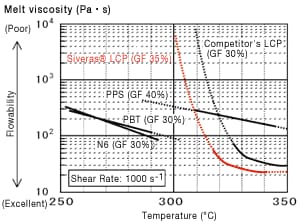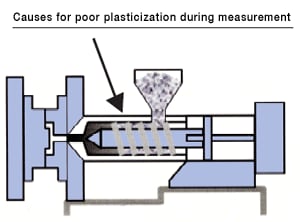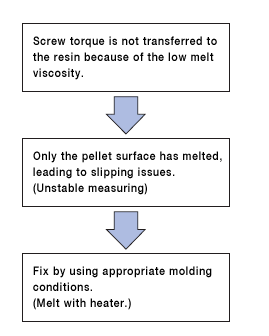- HOME
- Technical Information
- SIVERAS™ LCP Resin
- Characteristic (1)
Characteristic (1)
Great flowability
Generally speaking, LCP resin exhibits completely different flowability behavior than such crystalline polymers as PBT and PPS.

Temperature dependence of melt viscosity
These data are measurement values obtained
under specific
conditions and should not be
interpreted as guaranteed values.
- LCP resin exhibits low polymer viscosity at the range of temperatures used in injection-molding and excels in terms of flowability for thin products. The superb flowability makes it possible to mold at low pressure levels and helps prevent warpage.
- Meanwhile, at the flow end (the final filling stage) polymer viscosity increases rapidly, a phenomenon unique to liquid crystal polymers. That prevents barricades. These characteristics make it possible to use larger vents than those used with conventional engineering plastics.
- As Toray's SIVERAS™ LCP resin exhibits superior flowability compared to competitor LCPs, it enjoys the above advantages to an even greater degree.
Things to keep in mind when handling material with superb flowability
Ⅰ. Jetting
Because of its superb flowability, molding at inappropriately high injection speeds can result in jetting problems, where the polymer snakes its way through the cavity, causing air to be captured inside the cavity and leading to blisters in the molded product. Be careful not to raise the injection speed excessively.
Ⅱ. Variance in measurement time (poor plasticization)

Because SIVERAS™ has excellent flow ability
compared to competitor LCPs, its melt viscosity is lower.
Be sure to use appropriate molding conditions.

To avoid these problems and take full advantage of the benefits of SIVERAS™ LCP resin, there are four important factors:
(1) Resin choice
(2) Molding machine specifications
(3) Molding conditions
(4) Mold design